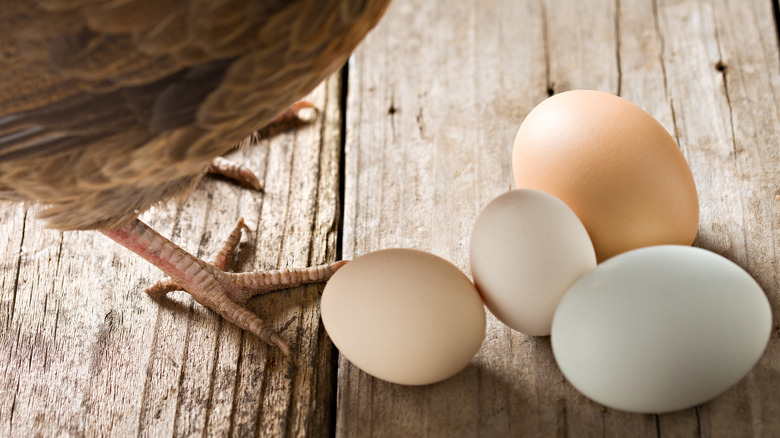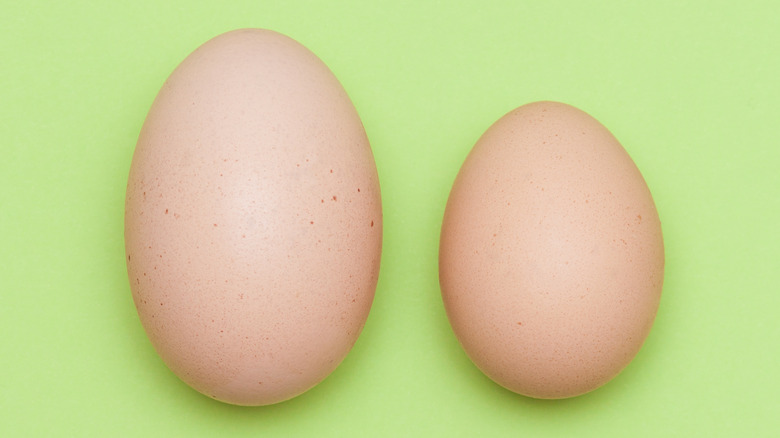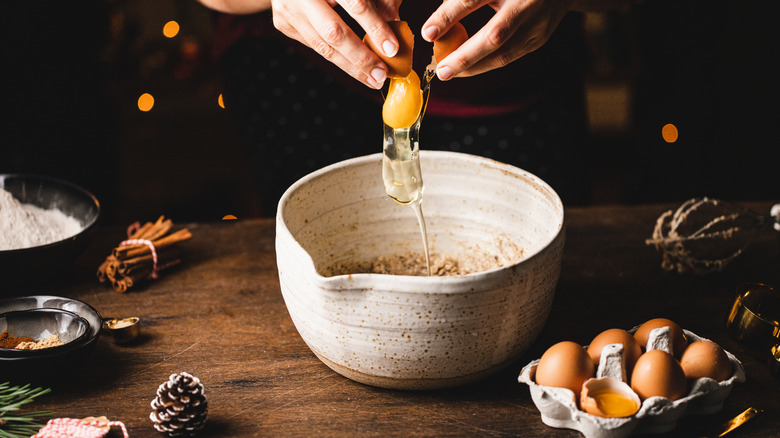Pullet Eggs Are A Pastry Chef's Best Kept Secret
No form of cooking is as sensitive to change as baking — where even the smallest modification can have a significant and noticeable effect. Something as little as using salted butter over an unsalted one can affect gluten and change the consistency of a dough. Sometimes, the only difference between a good bake and a great one can be the freshness of its ingredients, including the leaving agents. It's really no wonder then that pastry chefs often have a treasure trove of hard-learned tips and tricks that everyone can take away a thing to two from. Of all their many trade secrets, however, there's one game-changing tip that may very well be the best-kept secret to date — and that's pullet eggs.
Smaller in size than regular chicken eggs, a pullet egg has a higher ratio of yolk to white. The greater yolk content gives pullet eggs a rich flavor and a creamier texture, which is why they are a sought-after ingredient among pastry chefs. In fact, even Jamie Oliver thinks that those unfamiliar with pullet eggs are missing out on a truly exceptional ingredient (via Farmers Weekly)! Despite their popularity among chefs though, pullet eggs are not commonly available in supermarkets due to several factors and are usually only sought out by those who already know of the eggs' superiority.
What are pullet eggs?
Hens begin to lay eggs as soon as they are 18 weeks old, but have you ever wondered what these first few eggs look like? Do hens lay extra-large eggs that you see at grocery stores from the very beginning? Turns out, they don't. Hens take 30 weeks to reach the peak of their egg production, and until then, they produce eggs that are much smaller in size than the jumbo ones that most are familiar with. These eggs are named after a pullet, which is a hen that is no more than a year old. Essentially, chicken eggs begin to grow in size as the hen does, and pullet eggs are nothing but the first few eggs laid by a young hen.
A young hen will only produce pullet eggs for four weeks or so — after which, the eggs begin to get bigger, more even in size, and similar to those that are usually sold in supermarkets. Although these pullet eggs make for at least 10 percent of a farmer's overall yield, they are often thrown away or used to make powdered eggs due to their small size, which is perceived to be less bang for the buck compared to the larger eggs. If you were to listen to a pastry chef, however, they'd tell you that a pullet egg's small size is its biggest advantage as it affects the makeup of the yolks and whites inside, making it more desirable in certain preparations.
Why pastry chefs prefer pullet eggs
It is estimated that approximately 1.5 million pullet eggs are thrown away each year, all because they are roughly half the size of a regular egg. According to chefs like Jamie Oliver, however — who launched a campaign in 2015 to raise awareness of these little eggs — pullet eggs are more than just an unnecessary by-product of bigger and better chicken eggs because they tend to have a greater proportion of yolks to whites.
The higher ratio of yolk gives pullet eggs a rich flavor that is unique from that of regular chicken eggs — along with a more creamy texture – which makes them excellent eggs to use for anyone who usually reaches for an extra yolk in their baking. Pullet eggs will also add a deeper flavor and a bright yellow hue to yolk-based pastries like lemon tarts and crème brûlées as well as in desserts like custards. Additionally, pullet eggs are known to hold their shape much better, making them superior to regular eggs in poached and fried preparations.
Pullet eggs can be added to just about any recipe with eggs without much fuss. The only thing to keep in mind when substituting them in baking recipes is that you're going to need more of them. In general, if a recipe calls for extra large eggs, you should use twice the number of pullet eggs instead — whereas if it calls for medium or large ones, you'll simply need to use one extra pullet egg on top.



